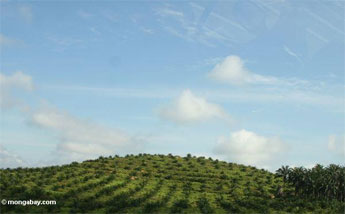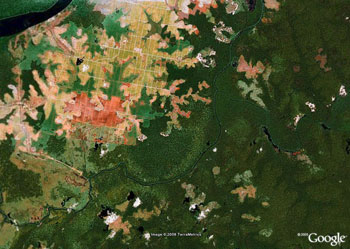Why is oil palm replacing tropical rainforests?
Why are biofuels fueling deforestation?
Rhett A. Butler, mongabay.com
April 25, 2006
[Update]
In a word, economics, though deeper analysis of a proposal in Indonesia suggests that oil palm development might be a cover for something more lucrative—logging.
Recently much has been made about the conversion of Asia’s biodiverse rainforests for oil-palm cultivation. Environmental organizations have warned that by eating foods that use palm oil as an ingredient, Western consumers are directly fueling the destruction of orangutan habitat and sensitive ecosystems.
So, why is it that oil-palm plantations now cover millions of hectares across Malaysia, Indonesia, and Thailand? Why has oil palm become the world’s number one fruit crop, trouncing its nearest competitor, the humble banana?
The answer lies in the crop’s unparalleled productivity. Simply put, oil palm is the most productive oil seed in the world. A single hectare of oil palm may yield 5,000 kilograms of crude oil, or nearly 6,000 liters of crude according to data from JourneytoForever. For comparison, soybeans and corn—crops often heralded as top biofuel sources—generate only 446 and 172 liters per hectare, respectively.
Beyond biofuel, the crop is used for a myriad of purposes from an ingredient in food products to engine lubricants to a base for cosmetics. Palm oil is becoming an increasingly important agricultural product for tropical countries around the world, especially as crude oil prices top $70 a barrel. For example, in Indonesia, currently the world’s second largest producer of palm oil, oil-palm plantations covered 5.3 million hectares of the country in 2004, according to a report by Friends of the Earth-Netherlands.
These plantations generated 11.4 million metric tons of crude palm oil with an export value of US$4.43 billion and brought in $42.4 million (officially) to the Indonesian treasury. Since then, the value of palm oil has only climbed. The price of palm oil currently stands at more than $400 per metric ton [by 2007 prices were more than twice this figure], translating to about $54 per barrel—quite cost competive to petroleum.
Despite the success of oil palm in Asia, it is not native to the region. The African oil palm (Elaeis guineensis) has its origins in tropical Africa, distributed from Sierra Leone to the Congo rainforest of the Democratic Republic of Congo. The species was introduced to Malaysia at the beginning of the 20th century and was first grown commercially in 1917.
Today almost half of Malaysia’s cultivated land consists of oil palm, and the country has become the world’s largest producer and exporter of palm oil, though Indonesia is quickly gaining ground. Both Indonesia and Malaysia are exporting large amount of the product to China: Malaysian exports to that country alone are expected to grow more than 20 percent from 2.9 million metric tons in 2005 to more than 3.5 million metric tons in 2006, representing almost 1 percent of the value of Malaysia’s total exports.
Palm oil is derived from the plant’s fruit, which grow in clusters that may weigh 40-50 kilograms. A hundred kilograms of oil seeds typically produce 20 kilograms of oil. Fruit clusters are harvested by hand, difficult work in the tropical climate where oil palms thrive. In Malaysia, much of palm oil harvesting is done by foreign workers, often Indonesians. While oil palms can live longer than 150 years and exceed 80 feet in the wild, cultivated palms are generally clear cut or poisoned once they are about 25 years old when they stand around 30 feet tall. Beyond 30 feet, harvesting fruit clusters is a challenge.
Palm oil is used as one of the raw materials in a biodiesel production, a fuel that is derived from vegetable oils or animal fats. In general, biodiesels are biodegradable and, when burned, have fewer emissions than traditional petroleum-based fuels. Typically, biofuels are blended with traditional petroleum-based fuels, though it is possible to run existing diesel engines purely on biodiesel, something which holds a great deal of promise as an alternative energy source to replace fossil fuels.
Traditionally environmentalists have been supportive of biofuels for their lower rates of pollution, while others like the idea of reducing dependence on Middle East oil since many biodiesel crops can be grown in friendly territories or even domestically produced. With this in mind, policymakers from Asia to Europe have shown interest and have made a major push to promote and adopt biofuels.
So, why is oil palm cultivation a concern? For environmentalists the problem with palm oil as a source of biodiesel lies in the nature of how the crop is produced. In recent years, vast areas of natural forest have been cleared across tropical Asia for oil palm plantations. This conversion has reduced biodiversity, increased vulnerability to catastrophic fires, and affected local communities dependent on services and products provided by forest ecosystems.
 Forest clearing in forest area near oil palm plantations in Kalimantan Photo by R. Butler
|
|
Beyond the loss of forest ecosystems, the production of palm oil, as currently practiced, can be quite damaging to the environment. In 2001 Malaysia’s production of 7 million tons of crude palm oil generated 9.9 million tons of solid oil wastes, palm fiber, and shells, and 10 million tons of palm oil mill effluent, a polluted mix of crushed shells, water, and fat residues that has been shown to have a negative impact on aquatic ecosystems.
Further, the liberal use of petroleum-based pesticides, herbicides, and fertilizers ensures that most palm- oil cultivation is not only polluting on a local level but also contributes to greenhouse gas emissions. Considering that Malaysia is held to be one of the most efficient producers, production in other parts of the world may be more polluting. Indonesian plantations are so damaging that after a 25-year harvest, oil- palm lands are often abandoned for scrubland. Soils may be so leached of nutrients, especially in acidic environments, that few other plants will grow, leaving the area essentially devoid of vegetation other than weedy grasses which serve as tinder for wildfires.
For these reasons, the scientific community is deeply concerned by a proposal by the Indonesian government to turn vast areas of Borneo‘s remote and biodiverse rainforests into oil-palm plantations. The proposed expanse of monoculture threatens to obliterate the region’s legendary biodiversity—the World Wildlife Fund (WWF) says some 361 species of animals have been discovered on the island in the past decade—while displacing local people, including the Dyaks, native forest dwellers renowned for their hunting and tracking prowess.
Ambitious plans:
According to a Friends of the Earth report, in the mid-1990s Indonesia set aside 9.13 million hectares for oil-palm cultivation. By 2004, only about 58 percent of this area was actually planted, though vast areas of natural forest had been cleared in the name of oil-palm production. For example, according to a paper by Lesley Potter of Australian National University, while only 303,000 hectares of the 2 million hectares of land in East Kalimantan reserved for oil-palm development had been planted, an estimated 3.1 million hectares of forest was cleared under the guise of plantation development.
 Orangutan in Kalimantan, photo by Rhett A. Butler. More pictures from Kalimantan Recent related articles Eco-friendly palm oil could help alleviate poverty in Indonesia |
|
Indonesia has announced that it plans to double oil-palm crude production by 2025, a goal that will require either a two-fold increase in yield—something which is entirely possible given trends in neighboring Malaysia—or an expansion in the area of oil palm under cultivation. The report says that Indonesia appears to be pursuing both options. Under a 2005 investment proposal, prepared by the State Plantation Corporation PT Perkenunan Nusantara (PTPN), Indonesia would develop about 1.8 million hectares in the Kalimantan/Malaysia border region, where most of Borneo’s remaining intact forests exist.
China would be involved in the plan, investing $7.5 billion in energy and infrastructure projects, including providing capital for palm-oil plantations. Chinese investors would directly control about 600,000 hectares of oil-palm plantations, while 1.2 million hectares would be slated for Indonesian companies. Based on extrapolations from an average 100,000 hectare concession, the total cost of the project is forecast by Friends of the Earth to be $8.6 billion.
The project would eventually employ nearly 400,000 people and generate an annual inflow of $45 million in tax revenue to the state. The PTPN proposal calls for plantations to be established in three national parks, Betung Kerihun (800,000 hectares), Kayan Mentarang (1,360,000 hectares), and Danau Sentarum (132,000) as well as surrounding “protection forest” and production forest under logging concessions.
According to Friends of the Earth, outside the parks, most forests areas in the region are under concession to logging firms, but due to the remoteness and lack of roads, few companies have fully logged their concessions.
For palm oil or something else?
On paper, given the vast area of tropical forest in the region and the relatively high value of palm oil, the plan may seem like a viable option from an economic standpoint. However, closer analysis of the suitability of the land for oil-palm cultivation has green groups questioning the stated purpose of the plan, suggesting that there may be other intentions.
Surveys of the region commissioned by WWF found that much of the land is poorly suited for oil palm. Mountainous terrain combined with inappropriate altitude and climate for oil palm means that only 10 percent at most can be considered adequate for cultivation and lends credibility to claims by environmental groups that the entire plan may be a cover for a massive logging scheme to harvest the area’s rich timber resources.
Greenomics, an Indonesian forestry non-governmental organization, has calculated the timber value in the border region at $26 billion. Logging the area set aside for oil-palm plantations would net substantial amounts of revenue for logging firms and considerable tax income for the Indonesian government. Further, since the oil palm project calls for extensive road construction, the infrastructure would be in place to deliver valuable—albeit previously inaccessible—timber to market.
Simultaneously, the government could extend its transmigration programs to settle colonists crowded on Java, something is has done extensively in other parts of Kalimantan. Finally the government would be able to slow the loss in tax revenue resulting from the burgeoning illegal timber trade in the border region—estimated a few years ago by the Indonesian ministry of forestry at 230,000 to 250,000 cubic meters of wood per month.
Given the prior record with oil-palm development and the inadequacy of the land in question, environmental groups suspect that should work commence on the project, forests outside the concession area would likely be cleared, with some landowners never intent on actually planting trees. The Friends of the Earth paper notes that “a lot of plantation concessions issued by the government are not truly developed into oil-palm greenfields. Instead, these lands appear to be abandoned as the concession holder does not work the land.”
For green groups, what’s particularly disturbing about this trend is that it is wasteful, occurring in some of the most biodiverse ecosystems on the planet. The paper cites a study by Greenomics that found “60 percent of all forest conversion for the purpose of planting oil-palm and pulpwood plantations still occurred in good forests in 2004-2005.”
A change of heart or more concealed intentions? On March 28, 2006, at the UN Convention on Biological Diversity in Curitiba, Brazil, the Indonesian government announced it would support an initiative by the WWF to conserve the “Heart of Borneo.” WWF concluded that this announcement meant Indonesia would abandon plans to create the world’s largest palm-oil plantation in the Kalimantan border region, leading environmental groups around the world to collectively rejoice that this biodiversity hotspot would not give way to development.
However, their enthusiasm may have come too soon. The Friends of the Earth report takes a different view of Indonesia’s announcement, stating, “these commitments do not mean, however, that plans to significantly expand oil-palm plantations in the border area are now canceled.” It says that Indonesian President Yudhoyono “has not made a formal statement to the general public that the border oil-palm project, as proposed by PTPN, is now canceled . . . [and that] the President remains a supporter of the overall border development programme.”
Further the report says, the government of Indonesia has previously agreed to make land available for oil-palm development with the Chinese and will not renege on this commitment. The report also notes that the government has announced additional plans to expand the oil-palm plantation area by 3 million hectares to meet the expected growth in demand for biofuel. Finally the report goes on to warn that “commitments made by the central government’s commitment may well be utterly ignored by provincial and district level governments.” Friends of the Earth suggests that Indonesia may have really not canceled the project after all.
Battle for the heart of Borneo.
While it is still unclear as to the status of the oil-palm plantations in central Borneo, the Friends of the Earth report lays out a set of recommendations for making better ecological and economic use of the rainforests of Kalimantan. The organization says a statement from Indonesian President Yudhoyono is needed to clarify the official status of the oil-palm project. If the government does intend to carry on with the proposed project, then it should first focus on increasing productivity in existing plantations, not on clearing new land for oil palm.
This can be done using improved seeds and doing a better job of adopting harvesting practices from other parts of the world, while encouraging replanting of abandoned and degraded plantations. Along these lines, the report argues that Indonesia would be wise to embrace agricultural certification for oil palm to ensure that products are coming from sustainable managed plantations.
 Oil palm plantation in Malaysia Photo by R. Butler
|
|
A set of criteria has already been established under the Principles and Criteria of the Roundtable for Sustainable Palm Oil (RSPO). A key part to any certification scheme is getting consuming nations on board. If these countries fail to demand palm oil from sustainable sources, then there will be no incentives for producers to manage their plantations in a sustainable manner. Therefore, says the report, industrialized countries must be encouraged to accept only oil-palm products derived from certified sources.
On a local level, Friends of the Earth argues that the Indonesian government should focus on assisting local communities to improve market access for non-timber forest products and agroforestry products, as well as minimizing the potential impact of any roads and related infrastructure projects that could result from the plan.
Finally to prove that it is serious about prosecuting misuse of oil-palm licenses, the Indonesian government needs to enforce existing laws. To date, few plantations operators have been fined or imprisoned for illegal deforestation or fire-setting, and landowners have little reason to follow existing regulations.
Beyond these recommendations, the current situation may present an opportunity for trading forest conservation for carbon emissions. Under an initiative proposed by 10 developing countries, industrialized countries would pay for rainforest conservation in exchange for earning “carbon credits” that would count toward their emissions targets under the Kyoto Protocol or other international agreements.
There may also be potential for private conservation initiatives whereby unlogged and undeveloped concessions are purchased by private parties and set aside for long-term environmental benefit.
Regardless of the path chosen, Friends of the Earth and associated environmental groups have made a strong case that the Indonesian government needs to own up to its intentions and make its decision based on careful evaluation of all available information. Because the country still has the most extensive tropical forest in Asia, its decisions on forest use are key to the long-term survivial of the region’s biodiversity and the ongoing maintenance of ecological services.
Related articles
